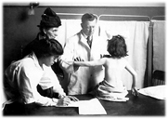History of Innovations | Overview
 1869 – Boston Children's Hospital is established for the medical and surgical treatment of the diseases of children. The first patients are admitted for orthopedic injuries, including a fractured wrist and fractured femur.
1869 – Boston Children's Hospital is established for the medical and surgical treatment of the diseases of children. The first patients are admitted for orthopedic injuries, including a fractured wrist and fractured femur.
1884 – The Charitable Surgical Appliance Shop opens at Boston Children's. The shop supplies braces to children suffering from conditions
such as osteomyelitis and tuberculosis.
Circa 1890 – In an attempt to halt the progression of curvature of the spine, Edward H. Bradford, MD, and Robert W. Lovett, MD, develop a plaster scoliosis jacket.
1890 – Edward H. Bradford, MD, and Robert W. Lovett, MD, produce the“Treatise on Orthopaedic Surgery,” considered to be the standard American orthopedic text of its time.
1897 – Edward H. Bradford, MD: his interest in scoliosis leads to the establishment of a specialized scoliosis clinic at Boston Children's.
1903 – Previously part of the Department of Surgery, Orthopedics and Sports Medicine Department is formally established as a separate department at Boston Children's.
1903 – Founder of the American Orthopaedic Association, Edward Bradford, MD, is appointed the first full professor of orthopaedic surgery at Harvard Medical School. Dr. Bradford's contributions to the field of orthopedics are numerous. He pioneered the development of equipment such as the Bradford Frame, a device developed to assist in the treatment of tuberculosis.
1903 – Osgood-Schlatter disease, an overuse condition and common cause of knee pain in adolescents, is recognized by Boston Children's Orthopedic Surgeon and Chief, Robert B. Osgood, MD, and Carl Schlatter, MD.
1910 – Legg-Calve-Perthes disease—a disorder in which the head of the femur (thighbone) loses its blood supply, which can lead to a collapse of the femoral head—is recognized by, and named after, Arthur Thornton Legg, MD, orthopedic surgeon at Boston Children's, Jacques Calve, MD, and George Perthes, MD.
1915 – Frank R. Ober, MD, develops the ligamentous procedure, a surgical technique for congenital equionovarus deformity, or clubfoot.
 1916 – Under the direction and leadership of Robert Lovett, MD, who organized the first polio clinic at Boston Children's, the Orthopedics and Sports Medicine Department leads the nation in the study and treatment of infantile paralysis. At the height of the polio epidemic in the northeast, teams from Boston Children's were sent to various locations along the Atlantic seaboard to care for, and teach other physicians to care for, children stricken with polio.
1916 – Under the direction and leadership of Robert Lovett, MD, who organized the first polio clinic at Boston Children's, the Orthopedics and Sports Medicine Department leads the nation in the study and treatment of infantile paralysis. At the height of the polio epidemic in the northeast, teams from Boston Children's were sent to various locations along the Atlantic seaboard to care for, and teach other physicians to care for, children stricken with polio.
During the epidemic, orthopedic surgeons at Boston Children's such as Frank Ober, MD, pioneer operative procedures for the weakness and contractures associated with this disease.
1910s-1920s – James Sever, MD, orthopedic surgeon at Boston Children’s from 1906-1949, recognizes and pioneers surgery for internal rotation contractures and external rotation weakness for infants and children with brachial plexus birth palsy.
1940 – A growth study initiated by William T. Green, MD, investigates the effects of polio on local bone and limb growth. Data from this study becomes an international standard for the prediction of growth, inform techniques for the correction of leg-length discrepancies and lead to Green-Anderson growth charts.
1950 – William Berenberg, MD, leads the development of a multidisciplinary team approach in treating cerebral palsy.
1971-2 – John Hall, MD, brings to Boston Children's the advanced practice of joint-preserving hip surgery through the techniques of inominate osteotomy (Salter's technique) and Chiari osteotomy to treat acetabular dysplasia.
1972 – John Hall, MD, and Mr. William Miller develop the Boston Brace System, a nonoperative means of treating idiopathic scoliosis and other spinal deformities. Hall also becomes a leading pioneer in scoliosis corrective surgery.
1974 – The first pediatric sports medicine clinic in the nation is founded at Boston Children's under the direction of Lyle Micheli, MD.
1975 – Boston Children's researchers Peter Hauschka, PhD, Jane Lian, PhD and Paul Gallop, PhD, discover osteocalcin in bone matrix (an abundant protein of mineralized bone). Osteocalcin contains three gamma-carboxyglutamic acid residues that bind calcium.
1983 – Boston Children's surgeons John Hall, MD and Michael Millis, MD, perform the first short-segment interior instrumentation and fusion for thoracolumbar scoliosis. This technique, fusing only three to four vertebrae, allows for correction of severe scoliosis while maintaining flexibility in selected patients, enabling virtually normal long-term activity.
1991 – For the first time at Boston Children's, orthopedic surgeons perform a Bernese periacetabular osteotomy.
1992 – Orthopedic surgeons in the Child and Adult Hip Preservation Program develop a modified surgical approach for the periacetabular osteotomy called the direct anterior approach. This advance further reduces the abductor morbidity formerly associated with acetabular redirectional procedures.
1992 – John Emans, MD, designs a new lumbosacral fixation device for the treatment of severe spondylolisthesis.
1997 – John Emans, MD, is a pioneer in the use and evaluation of pedicle screws in the treatment of adolescent idiopathic scoliosis.
1998 – John Emans, MD, and his colleagues in the Spinal Program are hand-selected as the second team in the world to perform a vertical rxpandable prosthetic titanium rib (VEPTR) operation, a surgical procedure designed to treat congenital scoliosis, congenital chest wall deformities and thoracic insufficiency syndromes.
1999 – In collaboration with researchers at Beth Israel Deaconess, Boston Children's surgeon and researcher, Young-Jo Kim, MD, Ph.D, applies a new imaging technique, delayed gadolinium enhanced magnetic resonance imaging of Cartilage (dGEMRIC). dGEMRIC is utilized to assess early osteoarthritis in patients with hip dysplasia. This new technique is proven to be more sensitive than standard x-rays in detecting arthritis.
2000 – Orthopedic Surgery at Boston Children's establishes a national, multi-center study of the treatment of brachial plexus birth palsy.
2001 – Young-Jo Kim, MD, PhD, introduces the surgical hip dislocation technique, devised by Professor Reinhold Ganz from Switzerland, to Boston Children’s. This dislocation technique allows for complete and safe access to the hip joint in treatment of hip deformities such as slipped capital femoral epiphysis and Perthes disease.
2001 – Thoracoscopic anterior spinal surgery, a technique that requires small incisions in the chest, reducing pain and recovery time as compared to conventional surgery, is performed by Boston Children's orthopedic surgeons.
2003 – The Orthopedics and Sports Medicine Department establishes the Clinical Effectiveness Research Center (CERC). The first of its kind, the CERC is established to provide evidence-based standards of care for children with musculoskeletal disorders throughout the world.
2003 – Orthopedic surgeon and researcher Martha Murray, MD, investigates a new approach in fixing tears to the knee's anterior cruciate ligament (ACL). The technique uses platelet-rich plasma and a collagen hydrogel to help facilitate the regeneration of the ligament tissue.
2005 – Boston Children's Child and Adult Hip Preservation Program performs its 700th acetabular redirection osteotomy.
2010 – The Sports Medicine Program pioneers research into the regeneration of ACL tissue and growth- plate-sparing surgeries for ACL repair in pre-adolescents led by Martha Murray,MD. Clinical trials begin in 2015.
2013 – The Surgical Simulation Program pioneers surgical training and injury prevention with pediatric orthopedic teaching modules for trainees and attending surgeons under Peter Weinstock, MD, and Don Bae, MD.
